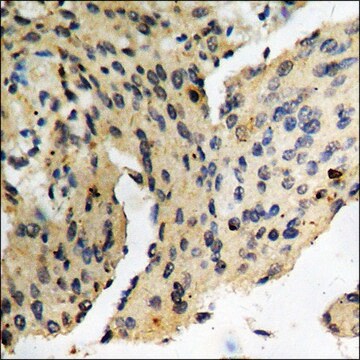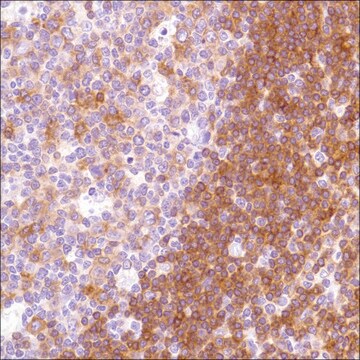MABF2160
Anti-MIC-A MIC-B Antibody, clone 6D4
clone 6D4, from mouse
Synonym(e):
MHC class I polypeptide-related sequence A/MHC class I polypeptide-related sequence B
About This Item
Empfohlene Produkte
Biologische Quelle
mouse
Antikörperform
purified immunoglobulin
Antikörper-Produkttyp
primary antibodies
Klon
6D4, monoclonal
Speziesreaktivität
human
Verpackung
antibody small pack of 25 μg
Methode(n)
flow cytometry: suitable
immunohistochemistry: suitable (paraffin)
inhibition assay: suitable
Isotyp
IgG2aκ
NCBI-Hinterlegungsnummer
UniProt-Hinterlegungsnummer
Posttranslationale Modifikation Target
unmodified
Angaben zum Gen
human ... MICA(100507436)
Verwandte Kategorien
Allgemeine Beschreibung
Spezifität
Immunogen
Anwendung
Entzündung & Immunologie
Flow Cytometry Analysis: A representative lot detected MIC-A and MIC-B in Flow Cytometry applications (Groh, V., et. al. (1999). Proc Natl Acad Sci U S A. 96(12):6879-84).
Inhibits Activity/Function Analysis: A representative lot inhibited cytotoxicity of ovary tumor-derived T cells against various cancer cell lines. (Groh, V., et. al. (1999). Proc Natl Acad Sci U S A. 96(12):6879-84).
Qualität
Flow Cytometry Analysis: 1 µg of this antibody detected MIC-A MIC-B in one million HeLa cells.
Zielbeschreibung
Physikalische Form
Lagerung und Haltbarkeit
Sonstige Hinweise
Haftungsausschluss
Not finding the right product?
Try our Produkt-Auswahlhilfe.
Analysenzertifikate (COA)
Suchen Sie nach Analysenzertifikate (COA), indem Sie die Lot-/Chargennummer des Produkts eingeben. Lot- und Chargennummern sind auf dem Produktetikett hinter den Wörtern ‘Lot’ oder ‘Batch’ (Lot oder Charge) zu finden.
Besitzen Sie dieses Produkt bereits?
In der Dokumentenbibliothek finden Sie die Dokumentation zu den Produkten, die Sie kürzlich erworben haben.
Unser Team von Wissenschaftlern verfügt über Erfahrung in allen Forschungsbereichen einschließlich Life Science, Materialwissenschaften, chemischer Synthese, Chromatographie, Analytik und vielen mehr..
Setzen Sie sich mit dem technischen Dienst in Verbindung.







